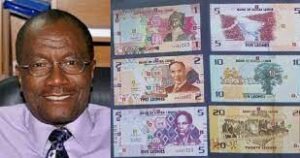The Governor of the central Bank of Sierra Leone has explicitly and succinctly put out the rationale behind the objective for currency redenomination in the country.“The current currency regime imposes several significant deadweight losses on the economy,” Bank Governor Professor Kelfala M. Kallon says.
The question of redenomination in Sierra Leone has been a challenging issue over the years, with people from various walks of life holding contrasting views about the initiative of getting the national currency redenominated, fearing that it is intended to force people with huge financial resources to deposit their money to the bank. Many are also of the view that the initiative would lead to the reduction of the value of their savings, whether in the bank or elsewhere.
However, the Bank Governor has advanced cogent and plausible reasons for currency redenomination in the country.
“Firstly, the huge quantities of banknotes needed to conduct simple transactions imposes huge transaction costs on economic activity,” the Bank Governor says. “Additionally, the costs borne by economic agents (households, businesses, and government agencies) in counting and storing large volumes of cash is also not trivial. These costs are compounded by the increasing costs of bookkeeping, the strain on the payment system, as evidenced by our crowded banking halls, long lines at Automatic Teller Machines (ATMs), and the general risk of theft.”
He also says the inconvenience customers will incur from counting huge stacks of currency when they withdraw cash from their bank accounts, as well as the high possibility that doing so will attract the attention of thieves lurking around in banking halls, has “created tremendous incentives for unscrupulous bank tellers to pilfer notes out of sealed bundles, thereby opening the financial system to the possibility of losing its most important asset” – which is the public’s trust.
Businesses, he notes, have also been taking advantage of the public when they round-off prices to the next thousand Leones. “For example, when a consumer presents 9,000 Leones to purchase something priced at 8.500 Leones, merchants essentially force customers to pay 9,000 Leones by claiming to have no change,” he explains, saying: “The cumulative effect of this has been tremendous ‘theft’ by businesses – just because the currency is so debased that prices are set in the thousands of it. By minting and circulating a whole new family of coins, in an adequate quantity, redenomination will bring much needed respite to the public from such scams.”
The Bank of Sierra Leone is not immune from these costs either, Prof Kallon says, adding that as the increasing debasement of the Leone creates the need for more currency notes, the Bank must allocate increasingly more of its meagre foreign exchange reserves to printing more notes whose face values are increasingly lower than the cost of printing them.
“In other words, whereas many central banks profit from their currency operations (in the form of seigniorage, which is the difference between the face value of a currency note and the cost of printing it), the Bank of Sierra Leone has been incurring huge losses in its currency operations,” the Governor says. “Thus, the current currency regime is imposing negative seigniorage on it. Redenomination will reduce the quantity of notes the Bank shall be printing going forward, thereby reducing the costs involved. Hopefully, this should help increase the seigniorage it receives.”
The Bank Governor defines redenomination as simply recalibration of a nation’s currency by dividing it by a constant. “In our case, that constant is 1,000, which is equivalent to removing three zeroes from the currency,” he says.














